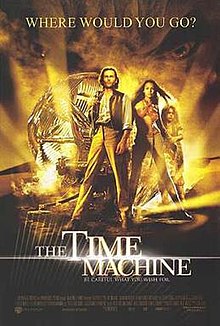
The Time Machine is a post-apocalyptic science fiction novella by H. G. Wells, published in 1895. The work is generally credited with the popularization of the concept of time travel by using a vehicle or device to travel purposely and selectively forward or backward through time. The term "time machine", coined by Wells, is now almost universally used to refer to such a vehicle or device.

George Pal was a Hungarian-American animator, film director and producer, principally associated with the fantasy and science-fiction genres. He became an American citizen after emigrating from Europe.
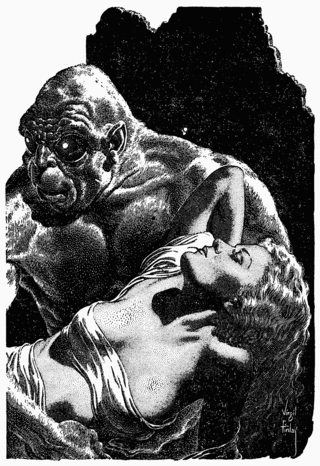
The Eloi are one of the two fictional post-human races, along with the Morlocks, in H. G. Wells' 1895 novel The Time Machine.

Superman is a 1978 superhero film based on the DC Comics superhero Superman, played by Christopher Reeve. It is the first of four installments in the Superman film series starring Reeve as Superman. The film was directed by Richard Donner based on a screenplay by Mario Puzo, David Newman, Leslie Newman, and Robert Benton. In addition to Reeve, the film features an ensemble cast including Marlon Brando, Gene Hackman, Jeff East, Margot Kidder, Glenn Ford, Phyllis Thaxter, Jackie Cooper, Trevor Howard, Marc McClure, Terence Stamp, Valerie Perrine, Ned Beatty, Jack O'Halloran, Maria Schell, and Sarah Douglas. It depicts the origin of Superman, including his infancy as Kal-El of Krypton, son of Jor-El (Brando), and his youthful years in the rural town of Smallville. Disguised as reporter Clark Kent, he adopts a mild-mannered disposition in Metropolis and develops a romance with Lois Lane (Kidder) while battling the villainous Lex Luthor (Hackman).

The Time Ships is a 1995 hard science fiction novel by Stephen Baxter. A canonical sequel to the 1895 novella The Time Machine by H. G. Wells, it was officially authorized by the Wells estate to mark the centenary of the original's publication. The Time Ships won critical acclaim. It won the John W. Campbell Memorial Award and the Philip K. Dick Award in 1996, as well as the British Science Fiction Association Award in 1995. It was also nominated for the Hugo, Clarke and Locus Awards in 1996.

Morlocks are a fictional species created by H. G. Wells for his 1895 novel The Time Machine. They are the story's main antagonists. Since their creation by H. G. Wells, the Morlocks have appeared in many other works such as sequels, films, television shows, and works by other authors, many of which have deviated from the original description.

Samantha Tamania Anne Cecilia Mumba is an Irish singer-songwriter, dancer, actress, fashion model and TV presenter. In 2000, at the age of 17, she shot to fame with the release of her debut single "Gotta Tell You", which reached the top five in Ireland, United Kingdom and the United States. It has since been listed in Billboard's 100 Greatest Choruses of the 21st Century. Her album of the same name was released later that year and reached number four in Ireland and number nine in the UK. She has had seven top five hits in Ireland and six top ten hits in the United Kingdom.
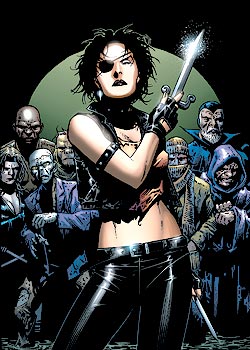
Callisto is a character appearing in American comic books published by Marvel Comics and is associated with the X-Men. She is the leader of New York City's subterranean mutant settlement the Morlocks, until losing that post in a duel against Storm. Storm subsequently leaves the group in Callisto's care as her representative, and the two eventually form an uneasy alliance.
Social science fiction is a subgenre of science fiction, usually soft science fiction, concerned less with technology/space opera and more with speculation about society. In other words, it "absorbs and discusses anthropology" and speculates about human behavior and interactions.
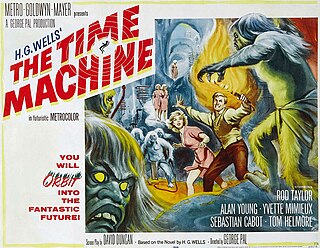
The Time Machine is a 1960 American period post-apocalyptic science fiction film based on the 1895 novella of the same name by H. G. Wells. It was produced and directed by George Pal, and stars Rod Taylor, Yvette Mimieux, and Alan Young. The story is set in Victorian England and follows an inventor who constructs a machine that enables him to travel into the distant future. Once there, he discovers that mankind's descendants have divided into two species, the passive, childlike, and vegetarian Eloi and the underground-dwelling Morlocks, who feed on the Eloi.
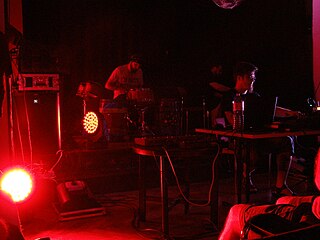
Weena Morloch is a German electronic music project by Samsas Traum frontman Alexander Kaschte. The name Weena Morloch came from the H. G. Wells book The Time Machine.

Another Country is a 1984 British romantic historical drama written by Julian Mitchell, adapted from his play of the same name. Directed by Marek Kanievska, the film stars Rupert Everett and Colin Firth in his feature film debut.

Moon is a 2009 science fiction film directed by Duncan Jones and written by Nathan Parker from a story by Jones. The film follows Sam Bell, a man who experiences a personal crisis as he nears the end of a three-year solitary stint mining helium-3 on the far side of the Moon. Kevin Spacey, Dominique McElligott, Kaya Scodelario, Benedict Wong, Matt Berry, and Malcolm Stewart also star. It premiered at the 2009 Sundance Film Festival and was released in selected cinemas in New York and Los Angeles on 12 June 2009. The release was expanded to additional theatres in the United States on 10 July and to the United Kingdom on 17 July. A follow-up film containing an epilogue to the film's events, Mute, was released in 2018. A third installment, a graphic novel called Madi: Once Upon A Time in the Future, was released in 2020.

Gulliver's Travels is a 2010 American fantasy adventure comedy film directed by Rob Letterman in his live-action directorial debut, produced by John Davis and Gregory Goodman, written by Joe Stillman and Nicholas Stoller with music by Henry Jackman. It is loosely based on Part One of the 1726 novel of the same name by Jonathan Swift, though the film takes place in the modern day and contains references to modern pop culture. It stars Jack Black in the title role, Jason Segel, Emily Blunt, Amanda Peet, Billy Connolly, Chris O'Dowd, T.J. Miller, James Corden and Catherine Tate, and is exclusively distributed by 20th Century Fox.
Arnold Leibovit is an American director, producer, and screenwriter of feature films and musical productions. An acting member of the Producers Guild of America, he has produced, directed, and written several feature films. As part of his career, he has devoted over 40 years to the work of George Pal. Included is the production of the George Pal biopic The Fantasy Film Worlds of George Pal, for which he received a CINE Golden Eagle Award in the Arts category in 1986 and The George Pal Memorial Award from The Academy of Science Fiction Fantasy and Horror Films in 1987. In addition, he produced other works focusing on Pal including The Puppetoon Movie.

Journey 2: The Mysterious Island is a 2012 American science fantasy action-adventure film directed by Brad Peyton and produced by Beau Flynn, Tripp Vinson and Charlotte Huggins. A sequel to Journey to the Center of the Earth (2008), the film is based on Jules Verne's The Mysterious Island (1875). It stars Dwayne Johnson, Michael Caine, Josh Hutcherson, Vanessa Hudgens, Luis Guzmán, and Kristin Davis. The storyline was written by Richard Outten, Brian Gunn and Mark Gunn, and the screenplay by Brian and Mark Gunn.

Men in Black is a series of American science fiction action comedy films directed by Barry Sonnenfeld, and based on the Malibu / Marvel comic book series The Men in Black by Lowell Cunningham, which was itself based on a UFO conspiracy theory. The first film, Men in Black, was released in 1997, the second film, Men in Black II in 2002, the third film, Men in Black 3 in 2012, and the fourth film, a spin-off Men in Black: International in 2019. Amblin Entertainment and MacDonald/Parkes Productions produced all four films and distributed through Columbia Pictures.
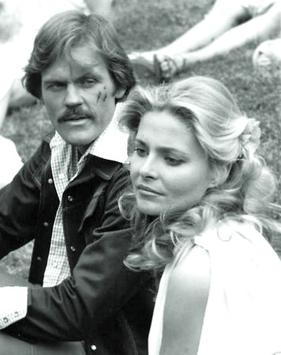
The Time Machine is a 1978 American made-for-television science fiction-adventure film produced by Sunn Classic Pictures as a part of their Classics Illustrated series. The film stars John Beck and Priscilla Barnes, and was broadcast November 5, 1978 during the November Sweeps on NBC.
Omero James Mumba is an Irish actor, writer, and director.
Weena is a fictional character in the novel The Time Machine, written by H. G. Wells in 1895 on the concept of time travel. In the story, an unnamed time traveler travels to 802,701 A.D. using his time machine, to find that humans have evolved into two species: the Eloi, the leisure class; and the Morlocks, the working class. He meets an Eloi girl named Weena, whom he takes on an expedition and loses in his battle against the Morlocks.
